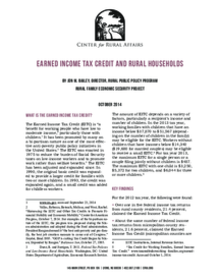Small Towns
The Earned Income Tax Credit (EITC) is an example of a social safety net, anti-poverty effort, the usage of which varies by place of residence.
This brief uses data from the Internal Revenue Service on usage of the EITC, and compares overall usage with U.S. Census Bureau geographic classifications of places of residence within the United Sates. EITC tax return claims by place of residence of tax filer are examined.
Key findings
For the 2012 tax year, the following were found:
- Over one in five federal income tax returns from rural county residents, 21.4 percent, claimed the Earned Income Tax Credit.
- About the same number of federal income tax returns from micropolitan county residents, 21.6 percent, claimed the Earned Income Tax Credit (micropolitan counties are those with small cities).
- The number of 2012 federal income tax returns from rural and micropolitan counties claiming the EITC was greater than the number of tax returns from metropolitan counties claiming the EITC.
- More people from rural counties claimed the EITC on their federal tax returns than those from metropolitan counties. The same was true of micropolitan counties.
- For rural and micropolitan areas combined – small cities, small towns and rural areas – 21.5 percent of all individual tax returns claimed an EITC, nearly 3 percentage points greater than metropolitan areas, and over 2 percentage points greater than the nation as a whole.
- Proposals to expand the EITC have the potential to provide the anti-poverty, income support, and economic stimulus benefits of the EITC in greater amounts to more people, particularly more low-income residents of rural and small city areas. More of these taxpayers qualify under the expanded proposals, especially those without qualifying children.


